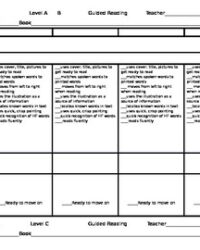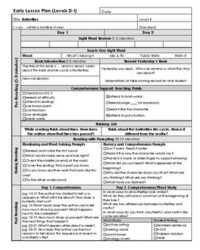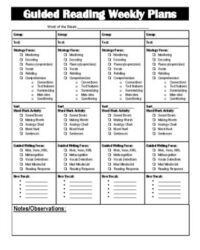Stepping into a classroom today often feels like orchestrating a symphony with musicians playing different instruments, reading various scores, and even marching to slightly different beats. Every student brings a unique set of strengths, challenges, learning styles, and prior knowledge. This beautiful diversity, while enriching, presents a significant challenge for educators trying to ensure every single learner not only keeps up but truly thrives. The traditional one-size-fits-all approach simply doesn’t cut it anymore, leaving some students disengaged and others unchallenged.
That’s where the magic of differentiation comes in – tailoring instruction to meet individual student needs. But how do you plan for such varied needs without getting overwhelmed? The answer lies in a structured approach, and a well-designed lesson plan template with differentiation is your secret weapon. It provides a clear framework, allowing you to proactively consider and integrate strategies that support every student, transforming potential chaos into harmonious learning.
Why Differentiation Isn’t Just a Buzzword Anymore
Differentiation is more than just a trending term in education; it’s a fundamental shift in pedagogical philosophy. It acknowledges the simple truth that learners are not uniform. Some students grasp concepts quickly, others need more time and varied explanations. Some learn best visually, others through hands-on activities, and still others thrive in collaborative settings. Ignoring these differences can lead to a classroom where some students feel left behind and others become bored, ultimately impacting their motivation and long-term academic success.
When you effectively differentiate, you’re not just making minor tweaks; you’re fundamentally altering the learning experience to make it more accessible and challenging for everyone. This includes adjusting content (what students learn), process (how they learn), product (how they demonstrate learning), and even the learning environment itself. The benefits extend beyond individual student success, fostering a more inclusive and equitable classroom where every child feels seen, valued, and capable of achieving their potential.
Embracing differentiation empowers teachers to move from merely delivering curriculum to truly facilitating learning. It encourages a deeper understanding of individual student profiles and requires thoughtful planning. This is precisely why a structured tool, like a lesson plan template designed specifically with differentiation in mind, becomes indispensable. It helps teachers systematically consider varying needs at the planning stage, rather than scrambling to react during the lesson.
Implementing differentiation doesn’t mean creating 25 different lesson plans for 25 different students. Instead, it involves thoughtful planning that anticipates common learning variations and builds in flexible options. This proactive approach saves time and reduces stress in the long run, leading to more engaging and effective lessons for all. It’s about building a versatile learning pathway, not a rigid highway.
Understanding Your Learners
Before you can differentiate effectively, you need to have a clear picture of your students. This involves ongoing assessment, observation, and building relationships. Knowing their interests, readiness levels, and preferred learning modalities will guide your planning decisions and help you pinpoint exactly where differentiation will be most impactful.
Key Elements for Effective Differentiation
While the specifics will vary by subject and grade level, effective differentiation often revolves around these core areas:
- **Content:** What students learn. This can involve providing texts at different reading levels, offering varied resources, or focusing on different aspects of a topic.
- **Process:** How students learn. This might include offering various ways for students to explore a concept, such as individual work, small group collaboration, or direct instruction with varied scaffolding.
- **Product:** How students demonstrate learning. Allow choices in how students show what they know, whether through a written report, a presentation, a model, or a performance.
- **Environment:** The setting for learning. Adjusting the physical space, noise levels, or availability of specific tools to support different learners.
Crafting Your Ideal Lesson Plan Template with Differentiation
A robust lesson plan template with differentiation isn’t just about adding a small box for “modifications.” It’s about integrating differentiated thinking throughout every stage of the planning process. It prompts you to consider, from the very beginning, how you will support struggling learners, challenge advanced ones, and engage everyone in between. This holistic approach ensures that differentiation isn’t an afterthought but a foundational element of your instructional design.
Such a template typically includes sections that encourage reflection on diverse learning needs. For instance, alongside your general learning objectives, you might note differentiated objectives or specific success criteria for different groups. When planning activities, the template guides you to think about tiered assignments, varied support during guided practice, and multiple options for independent work. This structured thinking helps ensure that every student has an appropriate entry point and a meaningful path to mastery.
The beauty of using a dedicated lesson plan template with differentiation is its ability to streamline your planning. Once you’ve developed a rhythm with it, you’ll find that anticipating and planning for diverse needs becomes second nature, transforming what might once have felt like an overwhelming task into an organized and effective routine. It empowers you to be more responsive and intentional as an educator.
Here are some essential sections you might find or want to include in your lesson plan template with differentiation:
- **Unit/Lesson Title & Subject:** Standard identification.
- **Grade Level(s) & Duration:** Practical details.
- **Learning Objectives/Standards:** What all students should know and be able to do, possibly with differentiated targets.
- **Materials:** All resources needed, including varied texts or tools for different groups.
- **Anticipatory Set/Hook:** How to grab students’ attention, considering diverse interests.
- **Direct Instruction:** Strategies for presenting new content, noting where varied explanations or examples will be used.
- **Guided Practice:** Activities where students practice with teacher support, specifying differentiated support levels.
- **Independent Practice/Application:** Tasks for students to work independently, including tiered assignments or choice boards.
- **Assessment:** How learning will be measured, offering diverse methods for students to demonstrate understanding.
- **Differentiation Strategies:** A dedicated section to explicitly list modifications for various groups (e.g., scaffolding for struggling learners, extension activities for advanced learners, alternative tasks for specific needs).
- **Technology Integration:** How technology supports differentiated learning.
- **Reflection/Next Steps:** Notes on what worked, what didn’t, and how to adjust for future lessons.
Adopting a lesson plan template with differentiation is more than just a planning tool; it’s a commitment to equitable and effective education for all students. It encourages teachers to be proactive, thoughtful, and responsive to the unique individuals in their care. By embedding differentiation into your daily planning, you’re not just managing a diverse classroom; you’re cultivating a dynamic learning environment where every student has the opportunity to shine, grow, and achieve their full potential.
Ultimately, the goal is to create a classroom where every student feels challenged appropriately and supported effectively. A structured template simplifies the complex task of differentiation, making it an achievable and sustainable practice. It transforms the daunting prospect of meeting varied needs into a systematic, rewarding process that benefits both teachers and, most importantly, the students who learn and thrive within its thoughtful design.


